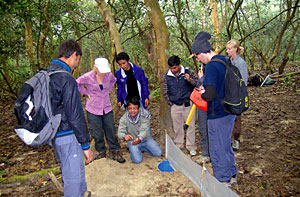 |
Since 2007, Jean Marc Hero has been bringing students from Griffith University in Australia to Nepal to take part in expeditions that focus on learning about environmental research and teaching methods.
The Program for Planned Biodiversity and Ecosystem Research (PPBio) aims to establish an international monitoring system that measures biodiversity and the long term effects of climate change.
Collaborative efforts between Griffith University and a number of environmental institutions within Nepal have resulted in the formation of PPBio Nepal.
With help from Bird Conservation Nepal, WWF Nepal, the� National Trust for Nature Conservation and the� Department of National Parks and Wildlife Conservation,� Australian and Nepali students from Tribhuvan University and Kathmandu University work together to research the minute differences in the habitat due to global warming.
"It's a fantastic collaboration. It's really nice for Australian students to see how many people can come together to get things done," says Hero.
Over the four-week course the students witness the ways in which PPBio is aiming to measure the effects of climate change as well as taking part in the various conservation research methods used by researchers in Chitwan National Park. The project is doing more than exposing Australian students to Nepal's environmental challenges, it also allows students to learn ways to deal with conservation and climate change issues.
PPBio has set up a 5x5-km-sized research plots as part of an international network of organised grids to gather and compare information using a standardised system of measurement that is available via an open-source database.
"What's unique about the system is that its systematic standardised methodology that can be applied anywhere in the world allows us to measure and monitor biodiversity and the impacts of climate change on a global scale. So we all work in exactly the same way at a local level, we're using the same plot size and the same measurements of birds, plants, frogs, lizards and mammals. So that if I measure the mammals on my plot in Australia, it's comparable to measuring a plot in Nepal or Brazil," explains Hero.
The plotted grids can currently be found in Brazil, Australia and Nepal with more in Costa Rica, New Zealand and the USA. As this international network grows, so too does the hope that research into environmental issues can advance far enough to understand the effects of climate change across the world.
However, it is not an easy feat. Hero says one of the biggest problems all over the world is establishing plots that can withstand environmental challenges. In Australia it is fire and human encroachment that pose the biggest threats to plots. In Nepal it's wild elephants that trample the plots. "We need to work out a system that is elephant proof," says� Hero.
Masters students from Tribhuvan University are using the plots as part of their research projects, and Hero believes that this is a positive step towards PPBio projects being handled by Nepali universities.
Climate change can have disastrous effects for Nepal, and not just with receding glaciers but also for migratory birds, plants and wildlife. PPBio offers the first step in finding out what is happening so we can� adapt to the changes.


